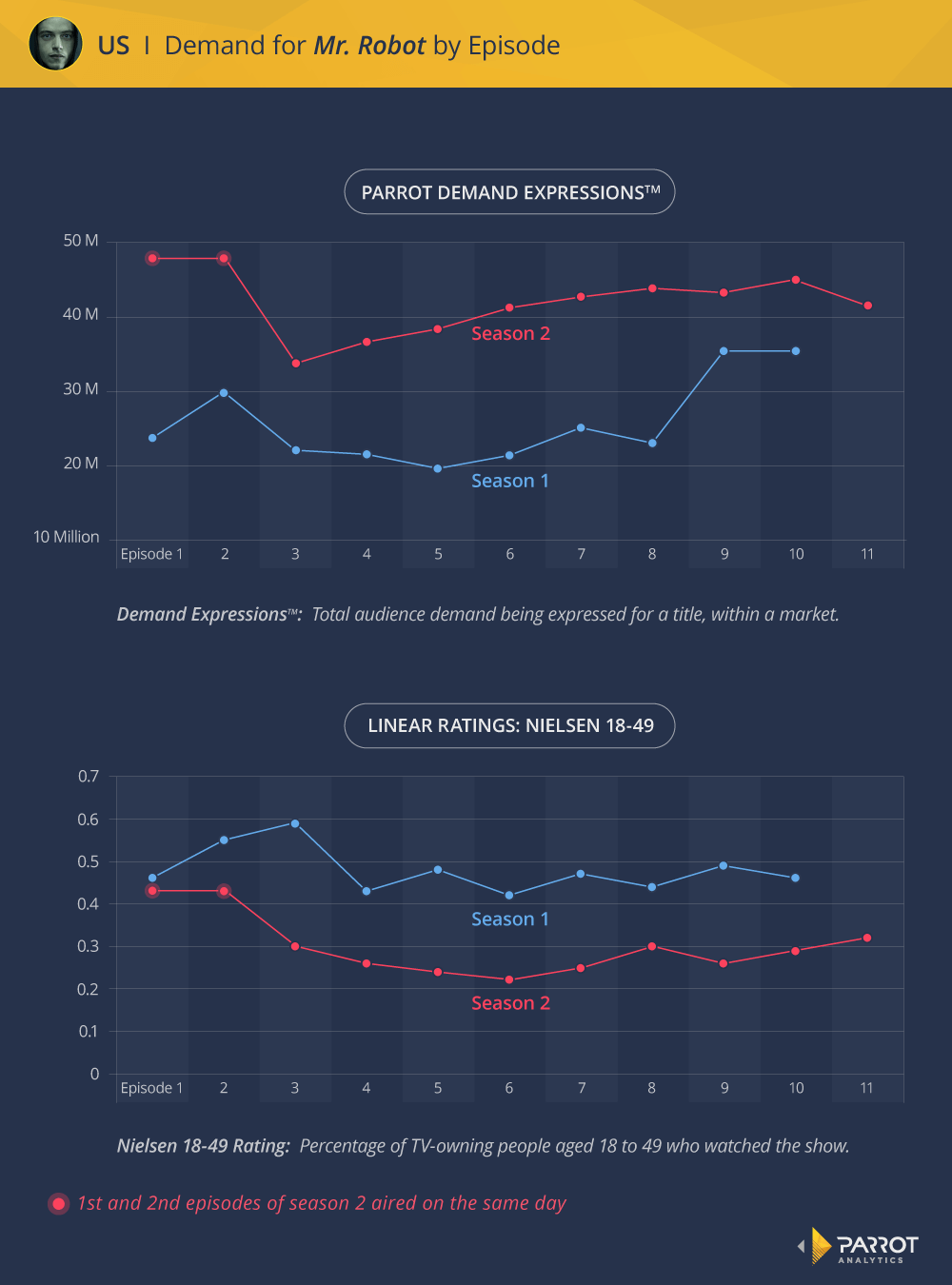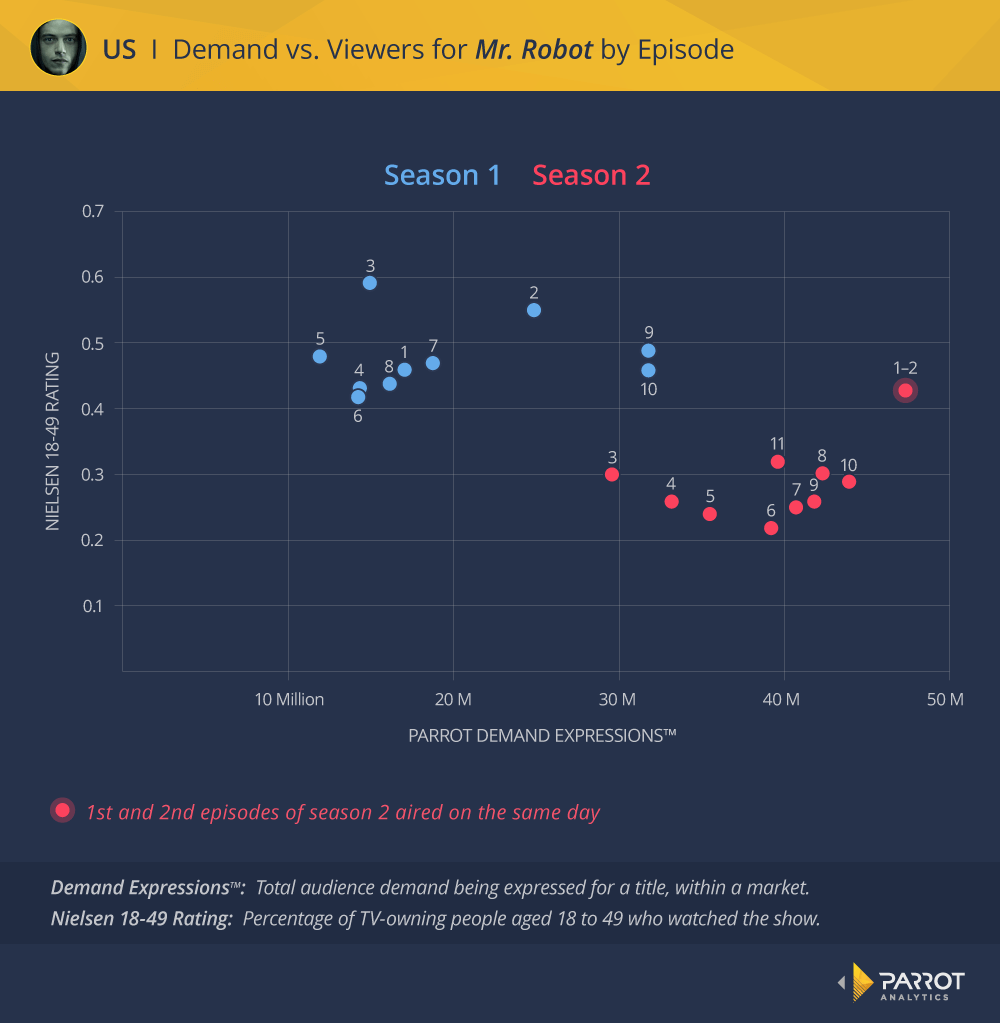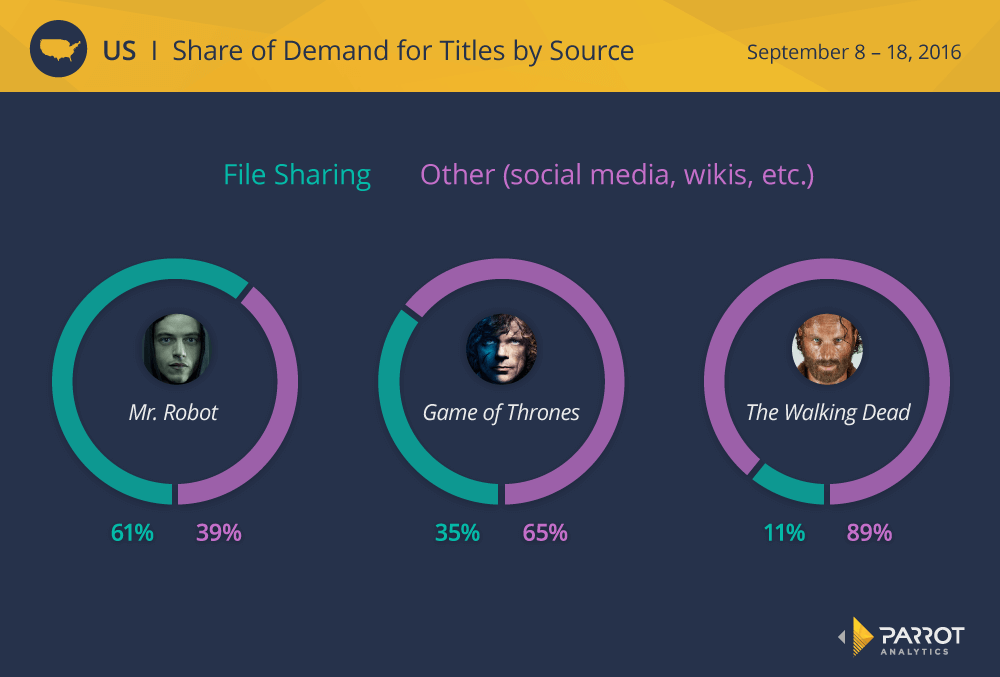While the first season of USA’s hit show Mr. Robot recently earned Rami Malek the Emmy for Outstanding Lead Actor, the second season has not been enjoying the same level of success.
This season premiered to a viewership lower than any episode from the first season, and the numbers have continued to decrease. The critics’ ratings are also lower for the second season than the first, which won the Golden Globe for Best Television Series in January. All this evidence paints a dire picture for the second season of this breakout hit, but has Mr. Robot’s overall popularity declined along with its views and critical acclaim?
Before considering the second season, we will go back to examine how the show’s popularity, as measured by Demand Expressions™ in the United States, compared to its linear ratings. The two measurements are on very different scales so the plot just compares their overall trends:

The Nielsen ratings for the show slowly declined over the first season, but were still high enough to earn the show an easy renewal. In contrast, the breakout hit nature of the show is clear from the Demand Expressions™: the trend of demand is positive and the season final had 86% more demand than the premiere. The rapid growth in popularity for Mr. Robot’s first season was not captured in the linear ratings, so perhaps the same is true for the underperforming second season.
However, on first glance it appears that the linear ratings and Demand Expressions™ follow similar patterns during the second season (excluding the finale, which will air on September 21st). Both viewers and demand declined by about 30% after the first two episodes, which both aired on July 13th, 2016. Though the linear ratings continued to decline until episode six, both measurements have trended up overall after the initial drop.
This upward trend in both measurements may look positive, but the problem for Mr. Robot’s linear ratings is the fact that they fell by an average of 40% from the previous season. The majority of television shows have declining ratings year to year, but such a large drop is disappointing for a show that was a breakout hit in its first season.
In contrast, the demand for Mr. Robot’s second season paint a much more optimistic picture. The average demand for the second season increased by over 100% — that is, it doubled — from the first season. This increase, the complete opposite of the trend in linear ratings, suggests that Mr. Robot’s popularity grew even when it was off the air as people discussed and shared the show with their friends. In fact, Mr. Robot has been the most in-demand title in the United States for the last two weeks (here and here); in terms of popularity, the second season is anything but a disappointment.
When demand and linear ratings are plotted against each other, the differences between them become even more apparent.

While the episodes in season one had higher linear ratings than all of season two’s episodes (except for episode 1 and 2), all the episodes in season two (except for episode 3) had higher demand than any of season one’s episodes. Demand and linear ratings for each season of Mr. Robot are not strongly correlated: its low viewership has no effect on its overall popularity.
If the many fans of Mr. Robot are not watching the show on TV, how are they interacting with it? To answer this question, the demand over the past 11 days (September 8th-18th) for Mr. Robot and two other popular titles is broken down by source. The largest difference between them is from the file sharing component: Mr. Robot has a much larger percentage of its demand from P2P activity than the other shows.

Instead of watching the show live on television, fans of Mr. Robot (which may be as tech-savvy as the show’s protagonists) are downloading the show from P2P sites. Notably, they are doing so at a higher rate than other popular shows. The Walking Dead gets most of its demand from social media and other sources, with only 11% from file sharing. Game of Thrones, cited as the most-pirated show in the world, still has the majority of its demand from other sources. The proportion from file sharing for these two shows may increase when they are airing new episodes, as Mr. Robot is, but the unusually large percentage of demand from P2P activity at least partially explains the low linear ratings for Mr. Robot.
Mr. Robot’s second season may have decreased in linear viewers and critical acclaim since its breakout first season, but demand for the show has never been higher. Its popularity doubled from the first to second season and is still increasing. Most of this demand is coming from consumption on file sharing platforms, indicating that many fans are turning to these sites to watch the show rather than tuning into traditional TV. Clearly linear ratings are no longer the only way to measure the success of a TV show, and by these new metrics, Mr. Robot is still a hit.

